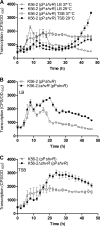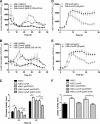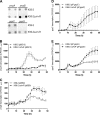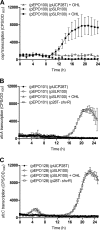The Burkholderia cenocepacia LysR-type transcriptional regulator ShvR influences expression of quorum-sensing, protease, type II secretion, and afc genes
- PMID: 20971902
- PMCID: PMC3019925
- DOI: 10.1128/JB.00852-10
The Burkholderia cenocepacia LysR-type transcriptional regulator ShvR influences expression of quorum-sensing, protease, type II secretion, and afc genes
Abstract
Burkholderia cenocepacia is a significant opportunistic pathogen in individuals with cystic fibrosis. ShvR, a LysR-type transcriptional regulator, has previously been shown to influence colony morphology, biofilm formation, virulence in plant and animal infection models, and some quorum-sensing-dependent phenotypes. In the present study, it was shown that ShvR negatively regulates its own expression, as is typical for LysR-type regulators. The production of quorum-sensing signal molecules was detected earlier in growth in the shvR mutant than in the wild type, and ShvR repressed expression of the quorum-sensing regulatory genes cepIR and cciIR. Microarray analysis and transcriptional fusions revealed that ShvR regulated over 1,000 genes, including the zinc metalloproteases zmpA and zmpB. The shvR mutant displayed increased gene expression of the type II secretion system and significantly increased protease and lipase activities. Both ShvR and CepR influence expression of a 24-kb genomic region adjacent to shvR that includes the afcA and afcC operons, required for the production of an antifungal agent; however, the reduction in expression was substantially greater in the shvR mutant than in the cepR mutant. Only the shvR mutation resulted in reduced antifungal activity against Rhizoctonia solani. ShvR, but not CepR, was shown to directly regulate expression of the afcA and afcC promoters. In summary, ShvR was determined to have a significant influence on the expression of quorum-sensing, protease, lipase, type II secretion, and afc genes.
Figures








Similar articles
-
A LysR Family Transcriptional Regulator Modulates Burkholderia cenocepacia Biofilm Formation and Protease Production.Appl Environ Microbiol. 2021 May 26;87(12):e0020221. doi: 10.1128/AEM.00202-21. Epub 2021 May 26. Appl Environ Microbiol. 2021. PMID: 33811025 Free PMC article.
-
Reciprocal regulation by the CepIR and CciIR quorum sensing systems in Burkholderia cenocepacia.BMC Genomics. 2009 Sep 17;10:441. doi: 10.1186/1471-2164-10-441. BMC Genomics. 2009. PMID: 19761612 Free PMC article.
-
Phenylacetyl Coenzyme A, Not Phenylacetic Acid, Attenuates CepIR-Regulated Virulence in Burkholderia cenocepacia.Appl Environ Microbiol. 2019 Nov 27;85(24):e01594-19. doi: 10.1128/AEM.01594-19. Print 2019 Dec 15. Appl Environ Microbiol. 2019. PMID: 31585996 Free PMC article.
-
Quorum sensing systems influence Burkholderia cenocepacia virulence.Future Microbiol. 2012 Dec;7(12):1373-87. doi: 10.2217/fmb.12.118. Future Microbiol. 2012. PMID: 23231487 Review.
-
The cis-2-Dodecenoic Acid (BDSF) Quorum Sensing System in Burkholderia cenocepacia.Appl Environ Microbiol. 2022 Feb 22;88(4):e0234221. doi: 10.1128/aem.02342-21. Epub 2022 Jan 5. Appl Environ Microbiol. 2022. PMID: 34985987 Free PMC article. Review.
Cited by
-
Membrane-enclosed Pseudomonas quinolone signal attenuates bacterial virulence by interfering with quorum sensing.Appl Environ Microbiol. 2023 Oct 31;89(10):e0118423. doi: 10.1128/aem.01184-23. Epub 2023 Oct 5. Appl Environ Microbiol. 2023. PMID: 37796010 Free PMC article.
-
Burkholderia cenocepacia ShvR-regulated genes that influence colony morphology, biofilm formation, and virulence.Infect Immun. 2011 Aug;79(8):2984-97. doi: 10.1128/IAI.00170-11. Epub 2011 Jun 20. Infect Immun. 2011. PMID: 21690240 Free PMC article.
-
Burkholderia cepacia Complex Regulation of Virulence Gene Expression: A Review.Genes (Basel). 2017 Jan 19;8(1):43. doi: 10.3390/genes8010043. Genes (Basel). 2017. PMID: 28106859 Free PMC article. Review.
-
First report on in-depth genome and comparative genome analysis of a metal-resistant bacterium Acinetobacter pittii S-30, isolated from environmental sample.Front Microbiol. 2024 Apr 29;15:1351161. doi: 10.3389/fmicb.2024.1351161. eCollection 2024. Front Microbiol. 2024. PMID: 38741743 Free PMC article.
-
Colony morphotype variation in Burkholderia: implications for success of applications and therapeutics.J Bacteriol. 2025 May 22;207(5):e0052124. doi: 10.1128/jb.00521-24. Epub 2025 Apr 14. J Bacteriol. 2025. PMID: 40227106 Free PMC article. Review.
References
-
- Ausubel, F., R. Brent, R. Kingston, D. Moore, J. Seidman, J. Smith, and K. Struhl. 1989. Current protocols in molecular biology, vol. 1. John Wiley & Sons, Inc., New York, NY.
Publication types
MeSH terms
Substances
Grants and funding
LinkOut - more resources
Full Text Sources

